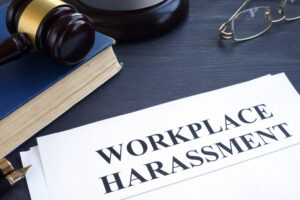Unwelcome and discriminating behavior that occurs at work is called harassment. While many people think of harassment purely in terms of sexual harassment, there are several other types of harassment. Under federal law, there are two main definitions of harassment: quid pro quo and hostile workplace.
More protection from workplace harassment is given to employees under several state legislation. Employers may be sued by victims for damages. Keep reading to learn more about harassment and then contact PLBH at (800) 435-7542.
What Does Workplace Harassment Entail?
Workplace harassment is a behavior that the victim finds offensive and targets the victim due to a protected status. Harassing conduct can include physical, such as groping, environmental, such as exhibiting improper images or laughing at terrible jokes, or verbal, such as employing slurs, name-calling, insulting epithets, or offensive jokes.
Depending on the victim’s viewpoint will determine whether or not that behavior is unacceptable. Nonetheless, a reasonable person must be insulted or intimidated by it in order for it to be considered unlawful and discriminatory.
Anybody has the potential to harass others at work. Among the potential harassers are supervisors, coworkers, customers, clients, and vendors.
Federal and State Laws Protect Employees
A federal law known as Title VII of the Civil Rights Act of 1964 recognizes a number of protected classifications. If one of these characteristics is the object of unwanted behavior, it may constitute harassment and discrimination: race, religion, skin tone, national origin, handicap, age, sex, sexual orientation, gender, and gender identity. Moreover, genetic data such family medical history and status as a pregnant person.
Some workers are additionally protected by other federal statutes. They consist of the Pregnancy Discrimination Act, Americans with Disabilities Act, and the Age Discrimination in Employment Act. Additionally, almost every state has its own anti-discrimination workplace laws. They generally follow the federal counterparts, but they might offer more rights against harassment.
Hostile Workplaces
Everyone, not just managers, can cultivate a hostile work atmosphere. Any protected trait may also be the target. Victims are not required to demonstrate that they were subjected to a concrete disciplinary punishment. It is not necessary for victims to experience a financial setback or a physical ailment in order to file a claim.
Harassment that affects employment circumstances is forbidden by federal anti-discrimination law. The acceptance of harassment as part of working in a hostile environment is a requirement for employment.
Nonetheless, for it to be considered unlawful harassment, the workplace must be hostile both subjectively and objectively. A reasonable person must find the working environment to be hostile, frightening, or offensive for it to be objectively hostile. The totality of the circumstances will determine whether the offensive or unpleasant behavior was severe or widespread enough to foster a hostile work environment.
If you have been the victim of harassment at work, you might have options. Contact PLBH at (800) 435-7542 to request a free legal consultation and learn what your rights are.

